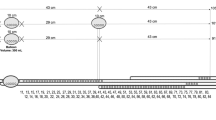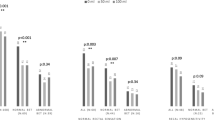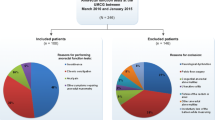Abstract
Rectal sensation is usually assessed using balloon distention. The authors describe a more precise technique that avoids the variables of balloon dynamics and rectal diameter and compliance. Using both methods, rectal sensation was assessed in 13 healthy control women and 26 women with severe idiopathic constipation. Balloon distention in the rectum revealed an elevated sensory threshold (16.9±4.4 vs. 30.4±3.1 ml air, controls vs. patients,P =0.018) and volume required to elicit a call to stool (61.1±9.1 vs. 97.5±6.4, P=0.003) in subjects with severe constipation. The maximum tolerated volume was similar in the two groups. Rectal mucosal electrosensitivity was then tested using a bipolar ring electrode supplying a constant current. This demonstrated an elevated sensory threshold in the constipated subjects (16.3±3.0 vs. 27.4±2.1 mAmps, P=0.005). There was a significant correlation between the sensation thresholds for balloon distention and electrical stimulation for the entire subject group (r=0.39,P =0.01). Two other patients with severe constipation after suspected extrinsic nerve damage were also studied and demonstrated a markedly abnormal electrical sensory threshold. Electrical testing avoided the variables inherent in balloon distention and was well tolerated, accurately quantifiable, and reproducible. The raised threshold to electrosensory mucosal testing suggests the presence of a rectal sensory neuropathy in patients with severe idiopathic constipation.
Similar content being viewed by others
References
Kiesswetter H. Mucosal sensory threshold of urinary bladder and urethra measured electrically. Urol Int 1977;32:437–48.
Rogers J, Henry MM, Misiewicz JJ. Combined sensory and motor deficit in primary neuropathic faecal incontinence. Gut 1988;29:5–9.
Roe AM, Bartolo DC, Mortensen NJ. New method for assessment of anal sensation in various anorectal disorders. Br J Surg 1986;73:310–12.
Baldi F, Ferrarini F, Corinaldesi R, et al. Function of the internal anal sphincter and rectal sensitivity in idiopathic constipation. Digestion 1982;24:14–22.
Read NW, Timms JM, Barfield LJ, Donnelly TC, Bannister JJ. Impairment of defecation in young women with severe constipation. Gastroenterology 1986;90:53–60.
Shouler P, Keighley MR. Changes in colorectal function in severe idiopathic constipation. Gastroenterology 1986;90:414–20.
Bland JM, Altman DG. Statistical methods for assessing agreement between two methods of clinical measurement. Lancet 1986;1:307–10.
Duthie HL, Gairns FW. Sensory nerve-endings and sensation in the anal region of man. Br J Surg 1960;47:585–94.
Gould RP. Sensory innervation of the anal canal. Nature 1960;187:337–8.
Goligher JC, Hughes ES. Sensibility of the rectum and colon. Its role in the mechanism of anal continence. Lancet 1951;1:534–538.
Last RJ. Anatomy: regional and applied. 7th ed. Edinburgh: Churchill Livingstone, 1984:328–9.
Gunterberg B, Kewenter J, Petersen I, Stener B. Anorectal function after major resections of the sacrum with bilateral or unilateral sacrifice of sacral nerves. Br J Surg 1976;63:546–54.
Krishnamurthy S, Schuffler MD, Rohrmann CA, Pope CE II. Severe idiopathic constipation is associated with a distinctive abnormality of the colonic myenteric plexus. Gastroenterology 1985;88:26–34.
Barnes PR, Lennard-Jones JE. Balloon expulsion from the rectum in constipation of different types. Gut 1985;26:1049–52.
Turnbull GK, Lennard-Jones JE, Bartram CI. Failure of rectal expulsion as a cause of constipation: why fibre and laxatives sometimes fail. Lancet 1986;1:767–9.
Turnbull GK, Bartram CI, Lennard-Jones JE. Radiologic studies of rectal evacuation in adults with idiopathic constipation. Dis Colon Rectum 1988;31:190–7.
Kamm MA, Lennard-Jones JE, Thompson DG, Sobnack R, Garvie NW, Granowska M. Dynamic scanning defines a colonic defect in severe idiopathic constipation. Gut 1988;29:1085–92.
Bazzocchi G, Ellis J, Meyer J, et al. Colonic scintigraphy and manometry in constipation, diarrhea and inflammatory bowel disease. Gastroenterology 1988;94:A29.
Devroede G, Lamarche J. Functional importance of extrinsic parasympathetic innervation to the distal colon and rectum in man. Gastroenterology 1974;66:273–80.
Burleigh DE. Evidence for a functional cholinergic deficit in human colonic tissue resected for constipation. J Pharm Pharmacol 1988;40:55–7.
Author information
Authors and Affiliations
Additional information
Michael A. Kamm is supported by the St. Marks Research Foundation.
About this article
Cite this article
Kamm, M.A., Lennard-Jones, J.E. Rectal mucosal electrosensory testing—Evidence for a rectal sensory neuropathy in idiopathic constipation. Dis Colon Rectum 33, 419–423 (1990). https://doi.org/10.1007/BF02156270
Issue Date:
DOI: https://doi.org/10.1007/BF02156270




